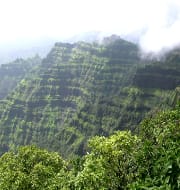Western Ghats’ forests vital for monsoon rainfall in Tamil Nadu: Study
Researchers have found that dense vegetation in Western Ghats determines amount of rainfall that Tamil Nadu gets during the summer monsoon. The study highlights importance of urgent need to stop deforestation in the Western Ghats.
Key Highlights of Study
Researchers had used models to compare contribution of Western Ghats with and without forest cover to study role of vegetation cover in Western Ghats in supplying moisture to southwest monsoon rainfall. They had selected three years (1993, 1999 and 2002) for their study when Tamil Nadu had experienced extreme deficit in summer monsoon rainfall.
The study found that dense forests of Western Ghats contribute as much as 40% of moisture to southwest monsoon rainfall over Tamil Nadu during normal monsoon years. The average contribution is 25-30%, but during monsoon deficit years, contribution increases to as high as 50%.
The forests of Western Ghats contribute as much as 3 mm per day of rainfall during August and September over majority of locations in Tamil Nadu and 1 mm per day during June and July. But when vegetation cover is removed from Western Ghats, there is significant drop in rainfall in range of 1-2.5 mm per day. This translates to average of 25% of total monsoon rainfall over Tamil Nadu.
The deforestation of forests in Western Ghats has led to 0.25 degree C increase in surface temperature across state. It has reduced rainfall over the State by 40-50% during all three years. If there is no vegetation in Ghats then Tamil Nadu will be severely impacted especially during the monsoon-deficit years. The study shows that Western Ghats acts as capacitor and forest land and vegetation gets recharged with water during wet spell and during break periods moisture is released and which contributes to rainfall to state.
Month: Current Affairs - May, 2018


